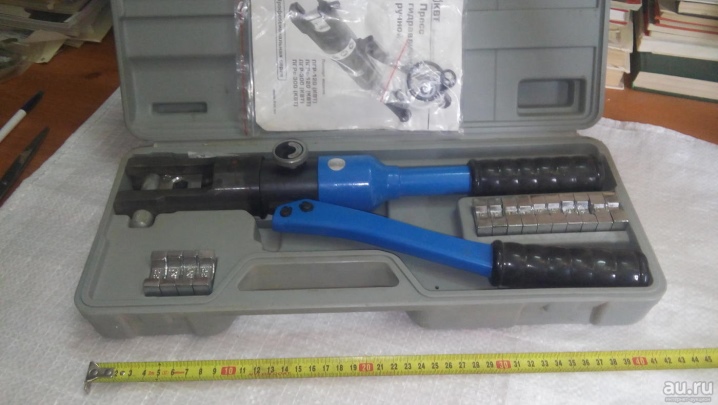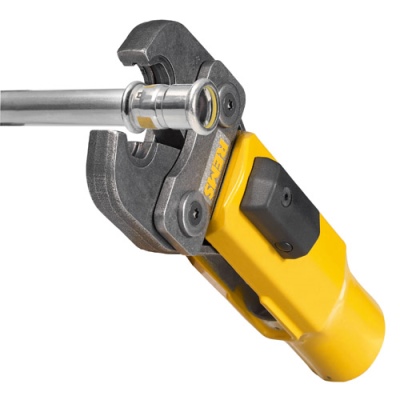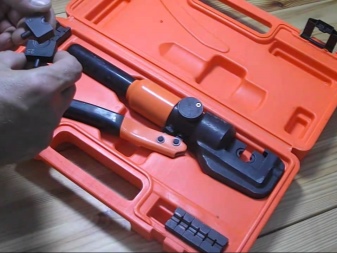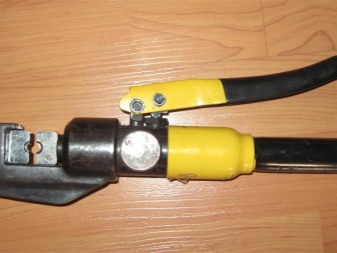Features and Uses of Hydraulic Press Pliers

The features of hydraulic press pliers and their use are not imagined by all people. At the same time, such equipment can be very useful for crimping wire ends and crimping sleeves. And also it is necessary to pay attention to the pliers for fittings of water pipes, to the presses of KBT and other manufacturers.

What it is?
In household and professional work, it is often necessary to use hydraulic press pliers. It is important to use them for crimping wire lugs when connecting various cable products to each other. This is not only about wiring in the narrow sense, as is often thought. The same need arises when connecting electrical equipment in industries, when installing household appliances. High-quality crimping pliers help crimp wires of various modifications.

But not only this is their main advantages. Often, pressing tongs are used to crimp sleeves for water pipe fittings. And not only plumbing - you can work with water and steam heating systems. This approach allows you to perform installation work better and in less time. The plumbing crimping tool appeared in the 1950s and was patented some time later.
Official patents, however, did not begin to be granted until the next decade. The modern version of the device for hydraulic pressure testing of pipes appeared in 1972 thanks to the engineers of the Mannesmann company.

Since then, it has not undergone significant changes. In addition to the pressing tool itself, a hydraulic pump is included. The interaction of the parts is ensured by a special hose designed to work at high pressure.
The force created by the hydraulic drive was provided precisely thanks to this hose. The pliers squeezed the desired part (coupling) and rigidly attached it to the pipe. Such a press connection is an excellent replacement not only for welding and brazing, but also for other technological operations. Despite the absence of changes in the schematic diagram, rather serious adjustments to the device and its actions are constantly being made. Modern hydraulic pressing tongs are able to work not only with metal, but also with metal-plastic pipes.

Over the past decades, engineers have achieved, indeed, a lot. For example, the friction of the working parts is noticeably reduced. Reduced energy consumption and labor intensity. Crimped fittings are “engraved,” which allows you to clearly trace which tool was used. The workpieces are tested in laboratories, the resulting joints are checked for how tight they are and how strong they are to break.
Otherwise, work with electrical wiring is going on. In this case, the contact area is critical to ensure its quality. When choosing a press jaw for this purpose, the cross-section of the wires is taken into account. Ferrule crimping tools work in much the same way as other fixtures. The ends of the wires are fixed by laying them inside the crimping sleeve.

Views
Manual hydraulic presses are most in demand and attractive in both the household and professional segments. They allow you to abandon the application of large physical efforts. As a result, dimensions and weight are reduced. Hydraulic tools for working with metal-plastic pipes are designed for cross-sections:
-
16;
-
20;
-
26;
-
32 mm.


Not all hand-operated hydraulic actuators, however, are designed for the latter size. Sometimes, however, there are even larger models - designed for a crimp threshold of up to 50 mm. Hand-operated hydraulic tools work well in hard-to-reach areas - precisely because of their relatively small size. High-quality models are capable of working with copper and stainless steel structures. Electro-hydraulic presses are more like a gun or screwdriver. They are equipped with a replaceable battery or power adapter.

Top manufacturers
Among the main models stand out:
-
Ibosad products;
-
devices of the KBT brand;
-
April models, which are made in the PRC (with split hydraulic drive);
-
advanced hydraulic presses of the French brand Virax (pressure pipes no more than 26 mm);
-
Ridgid RP 340-B;
-
REMS Akku-Press ACC;
-
Rothenberger Romax AC Eco Basic 15705;
-
Rothenberger Romax Pressliner Eco.


How to use it correctly?
It is very important to measure the applied force and the section of the fitting sleeve... If it is large, then you will have to lengthen the handles by adding auxiliary fragments. In telescopic versions, the required fragments are simply pushed out. The fitting of the inner walls of the pipes is carried out using a calibrator. When the size is selected, it is necessary to insert the pipe into the fitting completely and to the end, which should be symbolized by a click or observing the pipe from the outside through the windows on the fitting itself.

Then the pliers are placed on the sleeve. Their handles pull together. The job is considered complete when a click occurs or full contact is achieved.
In a specific case, you must also be guided by the instructions for the device. If we are talking about crimping the wiring, then this must be done up to the greatest effort so that the spring assembly works.















The comment was sent successfully.